 Facebook
Facebook
 X
X
 Instagram
Instagram
 TikTok
TikTok
 Youtube
Youtube
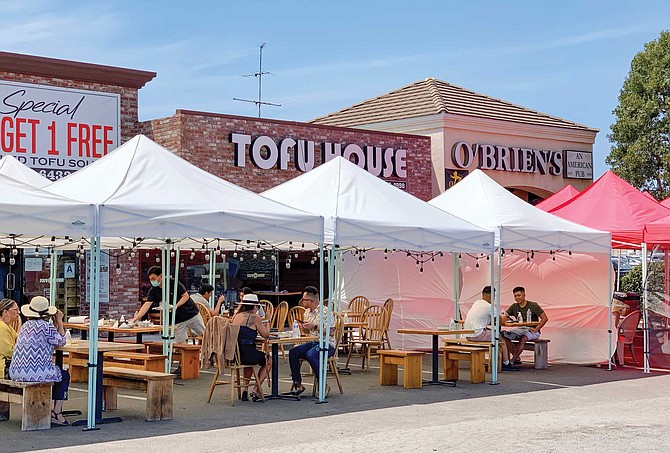
Outside Nolita Hall, a smattering of mid-evening diners met over tables arranged across a hundred feet of sidewalk, trees and garden landscaping weaving between them. The August sunset offered a glowing, turquoise sky and a strafing of wispy clouds that slowly graded from peach to salmon to pink. A trio of 20-somethings posed for selfies in front of the place while waiting for their Uber. Just like old times.
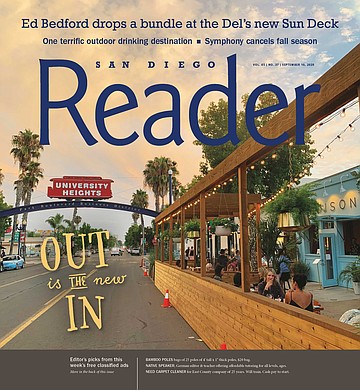
Except those sidewalk tables didn’t used to be there. Inside, the design-savvy restaurant at the north end of Little Italy covers six thousand square feet, enough to house its own shuffleboard courts and a massive, u-shaped bar. Westward facing roll-up doors open much of the restaurant directly to the sidewalk, so it never needed outdoor seating. Until July, when state and county restrictions made al fresco the only dine-in game in town.
That followed an awkward June experiment with socially distanced dining rooms, characterized by glass or plastic partitions between tables and body temperature scans upon entry. Coming on the heels of a ten-week shutdown, this was optimistic to the hospitality industry. But the experiment ended after a June when San Diego County in particular began to trace dozens of local outbreaks to restaurant and bar settings.
It was around that time that an employee of Nolita Hall tested positive for the virus. Owner Douglas Hamm closed the restaurant immediately, and notified the public via social media.
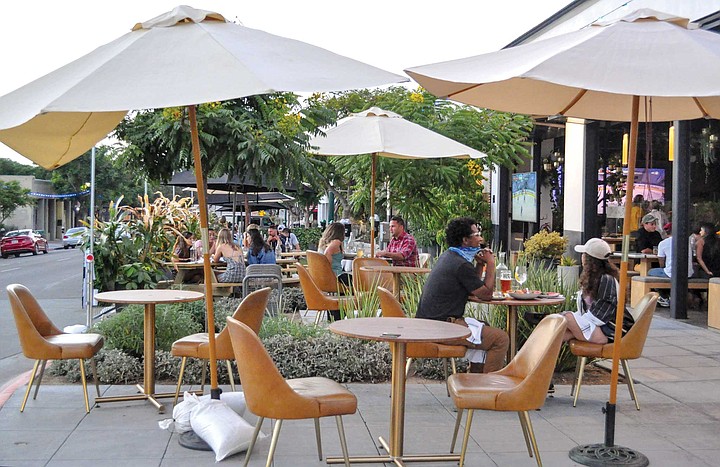
Though Nolita is one of the very few restaurants to be transparent about a staffer testing positive, Hamm stresses the situation is not one of the 50-plus community outbreaks county administrators attribute to restaurants and bar settings. At least, it didn’t wind up becoming an outbreak, because ultimately only that one employee tested positive for COVID-19, and thanks to safety precautions in place, it didn’t spread through the restaurant. As for that employee? “That’s part of the risk” Hamm says, “Nobody can control what people are doing outside of the restaurant.”
Hamm initially planned to close for two weeks, but by late June, San Diego’s dining situation looked likely to change. Amid uncertainty, he extended the hiatus and waited. “It’s one thing to operate under all the COVID guidelines and restrictions, and it’s a whole other animal when you’ve got to deal with a positive test,” Hamm says. “You’re essentially becoming an attorney, a doctor, and advisor for something that is new to everyone, even the experts.”
However, when the Little Italy Association and the city began facilitating use of sidewalks for outdoor dining, he watched to see how it played out. A real estate developer, Hamm owns the building his restaurant is in and therefore feels better situated than most to survive the loss in revenue. But the team operating his restaurant convinced him to re-open with outdoor seating.
“Our employees wanted to get back, our management wanted to get back. More than anything,” Hamm says, “that guided my decision. It wasn’t to make money,” he adds, “because it’s very difficult to turn a profit in this environment.”
Nolita had rebounded by the time I walked past during that August sunset. The sidewalk had been converted into a hundred-foot-long dining patio, its tables surrounded by plants, bounded by artificial turf, and topped with umbrellas for shade. One section sat across from a large television screen, remounted to face the street.
Though the restaurant has lost significant bar revenue and can only operate at about half its 300-person capacity, customers have returned. “I think it’s been such a success overall. People seem to be really enjoying it,” Hamm says, “Everyone’s embracing the outdoors on a different level that’s really positive.”
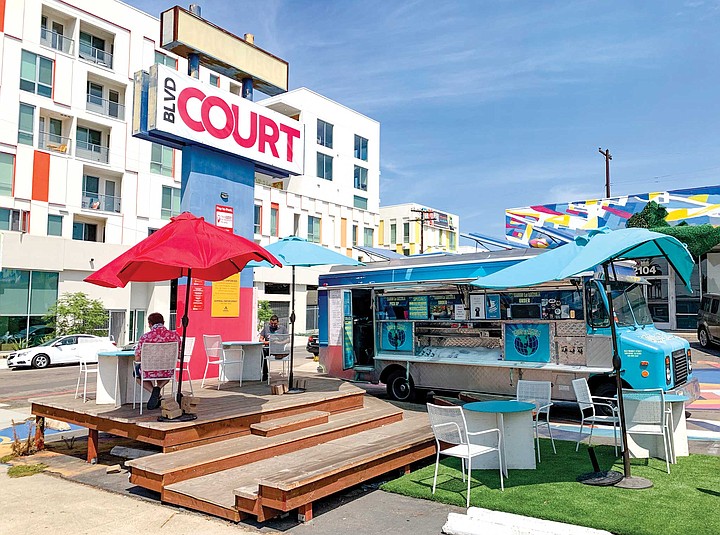
Speaking to a sampling of restaurant owners and outdoor diners, I sense a similar feeling taking root in San Diego this summer. As one outdoor diner told me, “It matches the whole summer vibe, being outside and being able to have drinks and watch the sun go down. It’s very European.”
At this writing, the COVID numbers have been trending downward, momentarily easing San Diego off the state’s COVID monitoring list, and potentially paving the way for indoor dining to resume. However, as warm temperatures continue, and with lower perceived risk attached to outdoor spaces, al fresco dining looks like the smart move for both restaurants and their guests for the foreseeable future, regardless of public policy.
Most of the restaurateurs I contacted for this story received Paycheck Protection Program loans from the Small Business Administration and benefited from tax deferrals initiated at the beginning of the pandemic. But approaching six months in, the stimulus funds have run out and back taxes are due. Without further government intervention, expect to see mass restaurant closures before the end of the year.
Another refrain I consistently heard was concern over the welfare and employment of their staff. The difficult choice: whether to protect employees by letting them seek unemployment benefits, or protect their long-term employment by keeping the restaurant going at reduced scale.
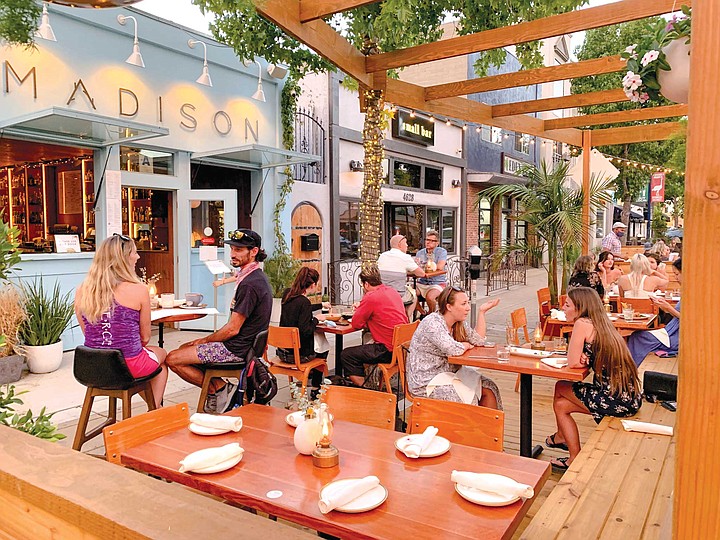
Joonsok Kim, owner of Tofu House restaurants in Kearny Mesa and Mira Mesa, brought a distinct perspective to this. The Korean restaurant has been a steady presence on Convoy Street for 22 years, but Kim suggests that if he closed the restaurant for any length of time, his employees might never come back.
“If I close more than two weeks or a month,” he says, “they’re not going to come back. They’ll move to a less expensive area, Arizona or Texas.” And they won’t easily be replaced. It’s not as though there are experienced Korean chefs floating around San Diego.
So Tofu House has pushed through the pandemic, and times have been rough. The restaurant is best known for rice bowls and soft tofu stews served at your table in scorching stone pots, still hot enough to cook raw eggs set among the banchan at your table. Dining take-out only from March through June, Tofu House couldn’t replicate the experience, and Kim says sales dropped to about 25 percent of the average. Even when indoor dining was allowed in June, business picked up to only about half the norm.
However, when the city facilitated using parking spaces to create outdoor seating, both Tofu House locations were able to add outdoor seating. In Kearny Mesa, that meant taking up a portion of the parking lot it shares with other restaurants, including RakiRaki Ramen and vaunted craft beer haven O’Brien’s Pub.
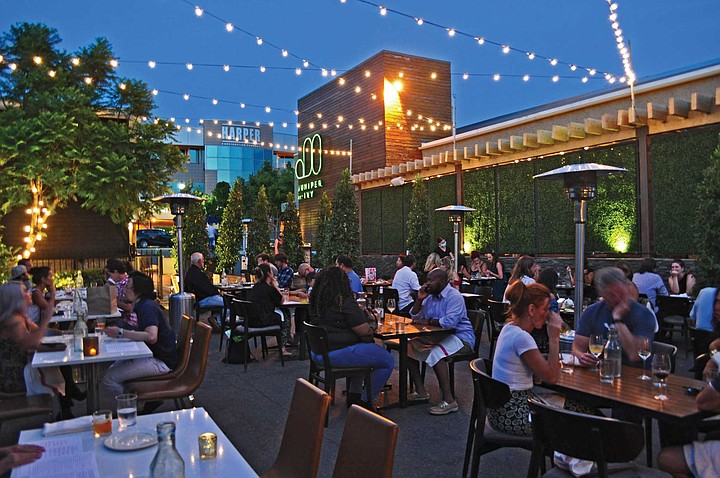
Tofu House couldn’t invest more than five grand to build its outdoor venue. It set up tents and Edison bulb strings, and moved its stone pot-scorched tables outside, lining them up between the painted rows of parking stalls, with hand sanitizer available atop every one. But seeing the usually crowded parking lot in dining action drives home the reality of how much of our outdoor spaces are dedicated to cars.
By combining parking lot dining with his take-out business, Kim says, “We are trying to catch up to 70 percent” of normal business.
The recent heat waves didn’t help, but Kim’s more concerned about fall weather at the moment. “I’m trying to figure out how to block the wind from October, November, December,” he says, “I’m talking to contractors and handymen about how to survive… maybe provide a heater or firepit or whatever we can do.”
Like everyone else, Kim can only hope the future offers a return to normalcy sooner than later. “As long as we can serve our food and stay open,” he says, “I’m willing to stay.”
Down in North Park, Francisco Moreno has managed to stick around on El Cajon Boulevard, finding an altogether different path outside.
Moreno launched his Tacos La Mezcla food truck seven years ago this month, operating outside by default. But over the past several years, he’s been working to move indoors and operate a permanent brick-and-mortar restaurant. About a year before the pandemic hit, he took over El Cajon Boulevard restaurant Twisted Taps, establishing it as a home base for his growing tacos and catering business.
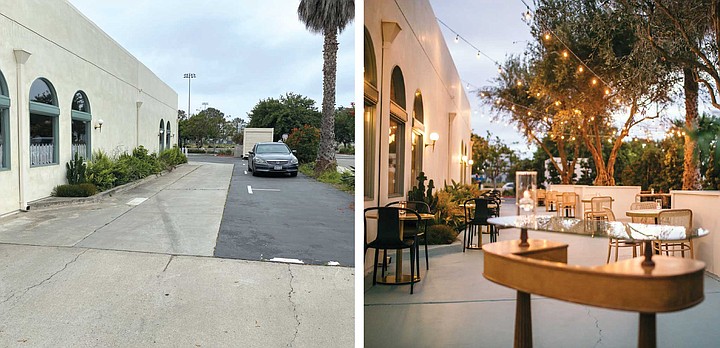
After the pandemic hit, the catering vanished, along with lucrative weekly truck bookings at corporate campuses and Balboa Park events. “Since March,” he says, “I’ve lost well over $100,000. With Balboa Park, another $60- or $70,000.”
By July, he was forced to give up his lease at Twisted Taps. Fortunately, he’d been an active member of the Boulevard Business Improvement Association, and had helped activate an unused corner parking lot dubbed the Blvd Court.
Shortly before the pandemic, a wood platform was installed for use during the association’s First Fridays monthly markets. Now, his food truck has a regular place to park six days a week, affording him a reliable location to bring back regular customers, and regenerate some revenue while all his hard-won gigs remain sidelined.
Moreno’s hope is that other food trucks will join the court for Taco Tuesday events, and that, as La Mezcla’s catering work picks back up, he’ll be able to sub in other local trucks needing a home. “So it’s consistent for people,” he says, “that there’s always food at 2104 El Cajon Boulevard.”
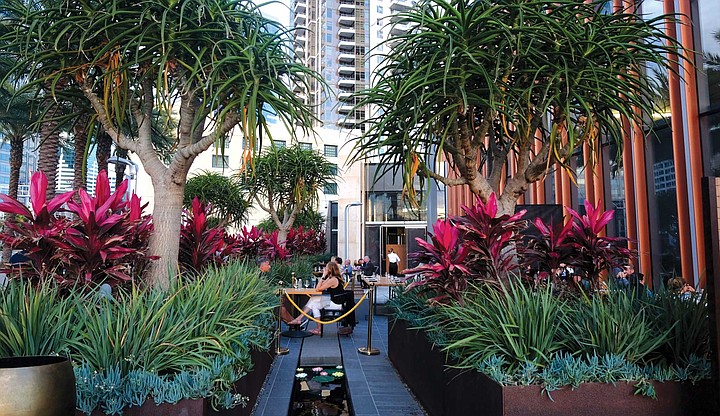
But, given current circumstances and the uncertain future of the restaurant industry, doubling down on his food truck business looks like a stronger move than trying to get back into a fixed restaurant location. Moreno hopes to add a second truck that will allow him to expand into North County, and he plans to put any further resources into establishing a central commissary to centralize his storage and food prep. While outdoor food service will remain his central gig, he’s more inclined to operate a ghost restaurant from the commercial kitchen. (That’s one that offers online ordering, with no dining room: to-go and delivery only.)
“There’s so many unknowns these next two years,” he says. “You have to shift the paradigm to what’s happening right now.”
Nearby, in University Heights, Small Bar has faced the struggle of many small restaurants: adapting, and re-adapting to the circumstances.
Small Bar remained open through the first months of the pandemic, and even provided free meals to out-of-work restaurant workers. But because of too little indoor space to offer socially distant seating, it never attempted indoor dining in June, and as other restaurants returned to business, owner Karen Barnett decided to bow out for a while; continuing to compete for take-out orders wasn’t worth exposing her staff to risk by keeping them working limited hours.
“The costs are still about the same as dine-in,” she says, “but it’s hard, sometimes the tipping isn’t there.” So she shut down to wait out the storm, while her staff did better seeking unemployment benefits.
However, with federal stimulus benefits expiring and state taxes due, Barnett is preparing to re-open in September, thanks in part to a new cedar parklet connected to the sidewalk out front, adding 20 outdoor seats to her business. “I don’t know if the parklet is going to carry me, but I’m going to try,” she says. Like so many other restaurant owners operating today, she adds, “There’s definitely no profit being made. It’s just to pay bills.”
Barnett continues to have reservations about whether the health risks behind re-opening are worthwhile, but 100 percent of her staff wants to return to work, she says, so she’s trying to do it right. “I’m planning to put a TV on my patio, so people can watch Padres games from the parklet and feel like they’re out somewhere,” she tells me, “People were quarantining so hard for those first couple months, they want to be outside.”
And like virtually every restaurant owner I spoke to, she also believes the industry will collapse this year without more government intervention. Nevertheless, she still hopes to provide meals to out of work industry folk in need, even as she worries a single hiccup could see her business go under. “Time will tell,” she says, “but that’s definitely thousands of dollars that I invest and hope for the best.”
The parklet helping Small Bar re-open is already built and in use. Taking the lead on its construction was a neighboring restaurant, Madison on Park.
Madison is known in part for its romantic interior, and the parklet was built by the same designers who built the arched cedar canopy central to its partially outdoor dining room. The new parklet floor occupies a half block of what used to be parking spaces along Park Boulevard. Its floorboards fit flush against the curb, like a natural extension of the sidewalk. Hanging plants and light strings add to the atmosphere beneath the colorful University Heights neighborhood sign.
Madison began using most of the parklet in August, but its end sections will be taken up by Small Bar and its opposite neighbor, Park & Rec.
The three restaurants “get along very well,” explains Madison owner Matt Sieve. “We came together to create something that is not only great for our businesses but provides a great experience in a much safer environment… We wanted to do it right, to be the example of how it should be done.”
Diners one recent night said they felt safe dining in the parklet. “This is my first time out since March,” one confided, “I’m so happy to be able to do this.”
Sieve calls the parklet a “significant investment in our community,” and suggests such constructs should be in use throughout the city. “San Diego has a climate comparable to many European cities, and we wanted to provide a similar experience,” he says. “Hopefully, legislation will follow to allow these parklets to be permanent.”
Madison’s pre-COVID capacity was around a hundred people, and with social distancing requirements, that number fell by more than half, to 45. The new parklet adds 34 seats, bringing it back to about 70 percent of the way to normal. But Sieve stresses that’s a huge gain in the current circumstances.
“We ran out of [Paycheck Protection Program] money weeks ago,” he says. “We’ve been losing money since then. We’re just hoping to break even until we get on the other side of this thing.” He adds, “Think about that, we have 70 plus seats and we’re hoping to break even. Most restaurants are operating with a fraction of that.”
Back in Little Italy, another upscale restaurant also invested big to create an outdoor environment, partly with the goal of putting guests more at ease.
“We have a lot of people who are still nervous to eat out,” says Dan Pena, director of operations for Juniper Hospitality, which operates Little Italy restaurant Juniper & Ivy. He notes that, for higher end restaurants, customers include those of older demographics, who don’t share the feeling of invincibility often possessed by the 20s and 30s crowd.
The business initially established a successful Juniper at Home take out program, and did re-open after indoor dining initially resumed in June. Pena says it was demoralizing when they had to shut down three weeks later, once again faced with the prospect of furloughing staff. “We said, ‘We’ve got to keep everyone working,’ and, ‘We’ve got to keep this thing going; we can’t just give up!’”
So within a week, Juniper spent upwards of $30,000 to create an “Under the Stars” venue in the small parking lot. In addition to string lights and custom wood furnishings, chef Anthony Wells added more wood-fired dishes to the menu to match the outdoor vibe.
The outdoor space can safely seat 80 diners, compared to a capacity of 125-plus in pre-COVID times, and even with the take out business supplementing sales, the restaurant is nowhere close to reclaiming the revenue lost to regular demand and seasonal convention center traffic. However, Pena says the restaurant is focused on making it through 2020. “Our biggest thing,” he says, “is trying to keep everybody employed.”
But that kind of investment isn’t made just for the three-week dining room ban initially touted by the county. Beyond this year, Pena still anticipates a need for the restaurant’s new outdoor venue. “Even when and if there’s a vaccine,” he says. “We still need to keep that outdoor space for people who don’t feel comfortable going back inside.”
Those nerves are real. One diner I spoke to talked about using discretion when choosing which restaurants to visit. “Restaurants need to recognize it can be done well,” she says, adding those that do it well pay attention to little details that include offering hand sanitizer stations. She avoids restaurants that don’t take the virus seriously. “I’ve seen places where I’ve been like, ‘Wow, everybody’s getting COVID today at that restaurant!’”
The largest investment I’ve seen was made by Carlsbad restaurant Jeune et Jolie. The upscale modern French eatery offered a small amount of patio seating prior to closing in March, but even before the state’s regulatory shift to all-outdoor dining, its owner made the decision to reopen as an all-outdoor restaurant.
John Resnick says he invested nearly $40,000 to convert the small parking lot on the side of the restaurant into an outdoor dining patio, beautifying the space with finished surfaces, string lights, and plants, including three mature, 20-foot olive trees to anchor the setting. Such improvements were necessary, he reasoned, to lure diners out of their homes.
“If guests were coming to Jeune, it would be out of a desire for some normality,” he says, “A desire to escape the trappings of all the issues and anxieties of the new-normal world.”
One diner I spoke to echoed the sentiment, suggesting that lingering pandemic anxiety may heighten the psychological value of an evening out. So long as she feels safe, she said, “To have a dining experience during this time is very special.”
Whereas most restaurants in the county have been conjuring up family combo meals and take-home cocktails in order to accommodate regular customers who are enduring the pandemic economy, Jeune et Jolie went the opposite direction, switching to a prix fixe tasting menu, prepaid at $95 per person.
“In the middle of a pandemic and a recession, it seems like prices should be lowered and cuisine made more comfortable. But we realized everyone was doing that,” Resnick says. “By creating a tasting menu-only restaurant, we could provide our community something that they could not find elsewhere, and hopefully, a sense of joy.”
Another part of the thinking behind the prix fixe menu was logistical. With the disruption to regular business, attendance fluctuates more than usual, making it tougher for restaurants to estimate how many ingredients they need to order any given week. “A prix fixe-only restaurant means it can be more efficient,” says Resnick, “No wasted product, no wasted labor dollars, etc. We buy what we need, and sell what we buy. It helps to eliminate waste during a time when doing so has never been more important.”
Consequently, since the restaurant’s “Starry Night” outdoor venue debuted in July, the restaurant has been surviving with reserved seating at 80 percent capacity. Resnick plans to keep it going at least through the end of the year, regardless of whether indoor dining resumes.
However, he points out how fortunate he’s been that the restaurant had that usable space to invest in. With a large public parking lot behind the restaurant, he hadn’t viewed the small parking area as necessary. “Our little parking lot has now saved us, as we certainly would be closed without it.”
Downtown, where Broadway meets the Marina district, upscale Asian fusion restaurant Animae may have the best pandemic outdoor dining venue in town. Stretched along the curved glass base of the 41-story luxury condo tower it calls home, it offers the sort of elegant ambiance fine dining aficionados have been craving during months of home isolation.
It’s within sight of the iconic, century-old Santa Fe Depot train station to the east, and offers expansive sunset views to the west. Its tables are scattered among palm trees and particolored plants, with a fountain pointing toward the towering, white metal sculpture dubbed Pacific Soul. Created by Spanish artist Jaume Plensa, the 25-foot figure fuses together characters of eight different alphabets to depict a person, crouching, hugging the knees and gazing out towards the ocean.
The sculpture was installed two years before anyone had heard of the novel Coronavirus, but its wistfulness resonates during the current crisis.
Compared to the $1.2 million price tag of Animae’s lavish and photogenic dining room, the under $5000 it spent to set up outdoor dining starts to look like a bargain for the fine dining restaurant. Especially given that it came as a plan B response to San Diego’s tightening of restrictions.
Puffer Malarkey Collective opened Animae a year ago as an instant sensation, but it hadn’t been open six months before the state shut down on-premise dining — on the eve of Animae’s revelation of a revamped menu, assembled by its James Beard-anointed chef Nate Appleman.
So, although Animae considered pursuing an upscale takeout menu, it ultimately received approval from the building’s HOA to take its service into the garden, to better highlight its talented new culinary director.
Puffer explains the decision: “We wanted our diners to experience Nate’s new menu with full service, and not out of a ‘to-go’ box.”
While most local restaurants shifted to take-out operations during the shutdown, fine dining establishments specifically thrive on service and atmosphere, so Puffer Malarkey restaurants closed, and waited.
At less than half its usual 170 guest capacity, Animae’s outdoor venue won’t return it to the restaurant’s previous earning potential. And even with its volumes and premium pricing, the restaurant group needed government assistance and outdoor dining to survive, the same as casual restaurants building parklets and putting up shade structures in parking lots.
“Without the PPP money, we would have had to make some very difficult calls,” Puffer says. “The PPP loans we received are helping keep all of our current locations alive.”
Whether the government will step in again by the fall to prevent the industry collapse that restaurant owners fear will be a matter of politics. Regardless, Puffer’s business partner points to another form of government reli ef that would be more likely to secure the near-term survival of local restaurants.
“What happens during COVID should stay after COVID,” says chef Brian Malarkey. “We should just continue to be allowed to serve food outside. And continue to sell cocktails to go.”


Outside Nolita Hall, a smattering of mid-evening diners met over tables arranged across a hundred feet of sidewalk, trees and garden landscaping weaving between them. The August sunset offered a glowing, turquoise sky and a strafing of wispy clouds that slowly graded from peach to salmon to pink. A trio of 20-somethings posed for selfies in front of the place while waiting for their Uber. Just like old times.

Except those sidewalk tables didn’t used to be there. Inside, the design-savvy restaurant at the north end of Little Italy covers six thousand square feet, enough to house its own shuffleboard courts and a massive, u-shaped bar. Westward facing roll-up doors open much of the restaurant directly to the sidewalk, so it never needed outdoor seating. Until July, when state and county restrictions made al fresco the only dine-in game in town.
That followed an awkward June experiment with socially distanced dining rooms, characterized by glass or plastic partitions between tables and body temperature scans upon entry. Coming on the heels of a ten-week shutdown, this was optimistic to the hospitality industry. But the experiment ended after a June when San Diego County in particular began to trace dozens of local outbreaks to restaurant and bar settings.
It was around that time that an employee of Nolita Hall tested positive for the virus. Owner Douglas Hamm closed the restaurant immediately, and notified the public via social media.

Though Nolita is one of the very few restaurants to be transparent about a staffer testing positive, Hamm stresses the situation is not one of the 50-plus community outbreaks county administrators attribute to restaurants and bar settings. At least, it didn’t wind up becoming an outbreak, because ultimately only that one employee tested positive for COVID-19, and thanks to safety precautions in place, it didn’t spread through the restaurant. As for that employee? “That’s part of the risk” Hamm says, “Nobody can control what people are doing outside of the restaurant.”
Hamm initially planned to close for two weeks, but by late June, San Diego’s dining situation looked likely to change. Amid uncertainty, he extended the hiatus and waited. “It’s one thing to operate under all the COVID guidelines and restrictions, and it’s a whole other animal when you’ve got to deal with a positive test,” Hamm says. “You’re essentially becoming an attorney, a doctor, and advisor for something that is new to everyone, even the experts.”
However, when the Little Italy Association and the city began facilitating use of sidewalks for outdoor dining, he watched to see how it played out. A real estate developer, Hamm owns the building his restaurant is in and therefore feels better situated than most to survive the loss in revenue. But the team operating his restaurant convinced him to re-open with outdoor seating.
“Our employees wanted to get back, our management wanted to get back. More than anything,” Hamm says, “that guided my decision. It wasn’t to make money,” he adds, “because it’s very difficult to turn a profit in this environment.”
Nolita had rebounded by the time I walked past during that August sunset. The sidewalk had been converted into a hundred-foot-long dining patio, its tables surrounded by plants, bounded by artificial turf, and topped with umbrellas for shade. One section sat across from a large television screen, remounted to face the street.
Though the restaurant has lost significant bar revenue and can only operate at about half its 300-person capacity, customers have returned. “I think it’s been such a success overall. People seem to be really enjoying it,” Hamm says, “Everyone’s embracing the outdoors on a different level that’s really positive.”

Speaking to a sampling of restaurant owners and outdoor diners, I sense a similar feeling taking root in San Diego this summer. As one outdoor diner told me, “It matches the whole summer vibe, being outside and being able to have drinks and watch the sun go down. It’s very European.”
At this writing, the COVID numbers have been trending downward, momentarily easing San Diego off the state’s COVID monitoring list, and potentially paving the way for indoor dining to resume. However, as warm temperatures continue, and with lower perceived risk attached to outdoor spaces, al fresco dining looks like the smart move for both restaurants and their guests for the foreseeable future, regardless of public policy.
Most of the restaurateurs I contacted for this story received Paycheck Protection Program loans from the Small Business Administration and benefited from tax deferrals initiated at the beginning of the pandemic. But approaching six months in, the stimulus funds have run out and back taxes are due. Without further government intervention, expect to see mass restaurant closures before the end of the year.
Another refrain I consistently heard was concern over the welfare and employment of their staff. The difficult choice: whether to protect employees by letting them seek unemployment benefits, or protect their long-term employment by keeping the restaurant going at reduced scale.

Joonsok Kim, owner of Tofu House restaurants in Kearny Mesa and Mira Mesa, brought a distinct perspective to this. The Korean restaurant has been a steady presence on Convoy Street for 22 years, but Kim suggests that if he closed the restaurant for any length of time, his employees might never come back.
“If I close more than two weeks or a month,” he says, “they’re not going to come back. They’ll move to a less expensive area, Arizona or Texas.” And they won’t easily be replaced. It’s not as though there are experienced Korean chefs floating around San Diego.
So Tofu House has pushed through the pandemic, and times have been rough. The restaurant is best known for rice bowls and soft tofu stews served at your table in scorching stone pots, still hot enough to cook raw eggs set among the banchan at your table. Dining take-out only from March through June, Tofu House couldn’t replicate the experience, and Kim says sales dropped to about 25 percent of the average. Even when indoor dining was allowed in June, business picked up to only about half the norm.
However, when the city facilitated using parking spaces to create outdoor seating, both Tofu House locations were able to add outdoor seating. In Kearny Mesa, that meant taking up a portion of the parking lot it shares with other restaurants, including RakiRaki Ramen and vaunted craft beer haven O’Brien’s Pub.

Tofu House couldn’t invest more than five grand to build its outdoor venue. It set up tents and Edison bulb strings, and moved its stone pot-scorched tables outside, lining them up between the painted rows of parking stalls, with hand sanitizer available atop every one. But seeing the usually crowded parking lot in dining action drives home the reality of how much of our outdoor spaces are dedicated to cars.
By combining parking lot dining with his take-out business, Kim says, “We are trying to catch up to 70 percent” of normal business.
The recent heat waves didn’t help, but Kim’s more concerned about fall weather at the moment. “I’m trying to figure out how to block the wind from October, November, December,” he says, “I’m talking to contractors and handymen about how to survive… maybe provide a heater or firepit or whatever we can do.”
Like everyone else, Kim can only hope the future offers a return to normalcy sooner than later. “As long as we can serve our food and stay open,” he says, “I’m willing to stay.”
Down in North Park, Francisco Moreno has managed to stick around on El Cajon Boulevard, finding an altogether different path outside.
Moreno launched his Tacos La Mezcla food truck seven years ago this month, operating outside by default. But over the past several years, he’s been working to move indoors and operate a permanent brick-and-mortar restaurant. About a year before the pandemic hit, he took over El Cajon Boulevard restaurant Twisted Taps, establishing it as a home base for his growing tacos and catering business.

After the pandemic hit, the catering vanished, along with lucrative weekly truck bookings at corporate campuses and Balboa Park events. “Since March,” he says, “I’ve lost well over $100,000. With Balboa Park, another $60- or $70,000.”
By July, he was forced to give up his lease at Twisted Taps. Fortunately, he’d been an active member of the Boulevard Business Improvement Association, and had helped activate an unused corner parking lot dubbed the Blvd Court.
Shortly before the pandemic, a wood platform was installed for use during the association’s First Fridays monthly markets. Now, his food truck has a regular place to park six days a week, affording him a reliable location to bring back regular customers, and regenerate some revenue while all his hard-won gigs remain sidelined.
Moreno’s hope is that other food trucks will join the court for Taco Tuesday events, and that, as La Mezcla’s catering work picks back up, he’ll be able to sub in other local trucks needing a home. “So it’s consistent for people,” he says, “that there’s always food at 2104 El Cajon Boulevard.”

But, given current circumstances and the uncertain future of the restaurant industry, doubling down on his food truck business looks like a stronger move than trying to get back into a fixed restaurant location. Moreno hopes to add a second truck that will allow him to expand into North County, and he plans to put any further resources into establishing a central commissary to centralize his storage and food prep. While outdoor food service will remain his central gig, he’s more inclined to operate a ghost restaurant from the commercial kitchen. (That’s one that offers online ordering, with no dining room: to-go and delivery only.)
“There’s so many unknowns these next two years,” he says. “You have to shift the paradigm to what’s happening right now.”
Nearby, in University Heights, Small Bar has faced the struggle of many small restaurants: adapting, and re-adapting to the circumstances.
Small Bar remained open through the first months of the pandemic, and even provided free meals to out-of-work restaurant workers. But because of too little indoor space to offer socially distant seating, it never attempted indoor dining in June, and as other restaurants returned to business, owner Karen Barnett decided to bow out for a while; continuing to compete for take-out orders wasn’t worth exposing her staff to risk by keeping them working limited hours.
“The costs are still about the same as dine-in,” she says, “but it’s hard, sometimes the tipping isn’t there.” So she shut down to wait out the storm, while her staff did better seeking unemployment benefits.
However, with federal stimulus benefits expiring and state taxes due, Barnett is preparing to re-open in September, thanks in part to a new cedar parklet connected to the sidewalk out front, adding 20 outdoor seats to her business. “I don’t know if the parklet is going to carry me, but I’m going to try,” she says. Like so many other restaurant owners operating today, she adds, “There’s definitely no profit being made. It’s just to pay bills.”
Barnett continues to have reservations about whether the health risks behind re-opening are worthwhile, but 100 percent of her staff wants to return to work, she says, so she’s trying to do it right. “I’m planning to put a TV on my patio, so people can watch Padres games from the parklet and feel like they’re out somewhere,” she tells me, “People were quarantining so hard for those first couple months, they want to be outside.”
And like virtually every restaurant owner I spoke to, she also believes the industry will collapse this year without more government intervention. Nevertheless, she still hopes to provide meals to out of work industry folk in need, even as she worries a single hiccup could see her business go under. “Time will tell,” she says, “but that’s definitely thousands of dollars that I invest and hope for the best.”
The parklet helping Small Bar re-open is already built and in use. Taking the lead on its construction was a neighboring restaurant, Madison on Park.
Madison is known in part for its romantic interior, and the parklet was built by the same designers who built the arched cedar canopy central to its partially outdoor dining room. The new parklet floor occupies a half block of what used to be parking spaces along Park Boulevard. Its floorboards fit flush against the curb, like a natural extension of the sidewalk. Hanging plants and light strings add to the atmosphere beneath the colorful University Heights neighborhood sign.
Madison began using most of the parklet in August, but its end sections will be taken up by Small Bar and its opposite neighbor, Park & Rec.
The three restaurants “get along very well,” explains Madison owner Matt Sieve. “We came together to create something that is not only great for our businesses but provides a great experience in a much safer environment… We wanted to do it right, to be the example of how it should be done.”
Diners one recent night said they felt safe dining in the parklet. “This is my first time out since March,” one confided, “I’m so happy to be able to do this.”
Sieve calls the parklet a “significant investment in our community,” and suggests such constructs should be in use throughout the city. “San Diego has a climate comparable to many European cities, and we wanted to provide a similar experience,” he says. “Hopefully, legislation will follow to allow these parklets to be permanent.”
Madison’s pre-COVID capacity was around a hundred people, and with social distancing requirements, that number fell by more than half, to 45. The new parklet adds 34 seats, bringing it back to about 70 percent of the way to normal. But Sieve stresses that’s a huge gain in the current circumstances.
“We ran out of [Paycheck Protection Program] money weeks ago,” he says. “We’ve been losing money since then. We’re just hoping to break even until we get on the other side of this thing.” He adds, “Think about that, we have 70 plus seats and we’re hoping to break even. Most restaurants are operating with a fraction of that.”
Back in Little Italy, another upscale restaurant also invested big to create an outdoor environment, partly with the goal of putting guests more at ease.
“We have a lot of people who are still nervous to eat out,” says Dan Pena, director of operations for Juniper Hospitality, which operates Little Italy restaurant Juniper & Ivy. He notes that, for higher end restaurants, customers include those of older demographics, who don’t share the feeling of invincibility often possessed by the 20s and 30s crowd.
The business initially established a successful Juniper at Home take out program, and did re-open after indoor dining initially resumed in June. Pena says it was demoralizing when they had to shut down three weeks later, once again faced with the prospect of furloughing staff. “We said, ‘We’ve got to keep everyone working,’ and, ‘We’ve got to keep this thing going; we can’t just give up!’”
So within a week, Juniper spent upwards of $30,000 to create an “Under the Stars” venue in the small parking lot. In addition to string lights and custom wood furnishings, chef Anthony Wells added more wood-fired dishes to the menu to match the outdoor vibe.
The outdoor space can safely seat 80 diners, compared to a capacity of 125-plus in pre-COVID times, and even with the take out business supplementing sales, the restaurant is nowhere close to reclaiming the revenue lost to regular demand and seasonal convention center traffic. However, Pena says the restaurant is focused on making it through 2020. “Our biggest thing,” he says, “is trying to keep everybody employed.”
But that kind of investment isn’t made just for the three-week dining room ban initially touted by the county. Beyond this year, Pena still anticipates a need for the restaurant’s new outdoor venue. “Even when and if there’s a vaccine,” he says. “We still need to keep that outdoor space for people who don’t feel comfortable going back inside.”
Those nerves are real. One diner I spoke to talked about using discretion when choosing which restaurants to visit. “Restaurants need to recognize it can be done well,” she says, adding those that do it well pay attention to little details that include offering hand sanitizer stations. She avoids restaurants that don’t take the virus seriously. “I’ve seen places where I’ve been like, ‘Wow, everybody’s getting COVID today at that restaurant!’”
The largest investment I’ve seen was made by Carlsbad restaurant Jeune et Jolie. The upscale modern French eatery offered a small amount of patio seating prior to closing in March, but even before the state’s regulatory shift to all-outdoor dining, its owner made the decision to reopen as an all-outdoor restaurant.
John Resnick says he invested nearly $40,000 to convert the small parking lot on the side of the restaurant into an outdoor dining patio, beautifying the space with finished surfaces, string lights, and plants, including three mature, 20-foot olive trees to anchor the setting. Such improvements were necessary, he reasoned, to lure diners out of their homes.
“If guests were coming to Jeune, it would be out of a desire for some normality,” he says, “A desire to escape the trappings of all the issues and anxieties of the new-normal world.”
One diner I spoke to echoed the sentiment, suggesting that lingering pandemic anxiety may heighten the psychological value of an evening out. So long as she feels safe, she said, “To have a dining experience during this time is very special.”
Whereas most restaurants in the county have been conjuring up family combo meals and take-home cocktails in order to accommodate regular customers who are enduring the pandemic economy, Jeune et Jolie went the opposite direction, switching to a prix fixe tasting menu, prepaid at $95 per person.
“In the middle of a pandemic and a recession, it seems like prices should be lowered and cuisine made more comfortable. But we realized everyone was doing that,” Resnick says. “By creating a tasting menu-only restaurant, we could provide our community something that they could not find elsewhere, and hopefully, a sense of joy.”
Another part of the thinking behind the prix fixe menu was logistical. With the disruption to regular business, attendance fluctuates more than usual, making it tougher for restaurants to estimate how many ingredients they need to order any given week. “A prix fixe-only restaurant means it can be more efficient,” says Resnick, “No wasted product, no wasted labor dollars, etc. We buy what we need, and sell what we buy. It helps to eliminate waste during a time when doing so has never been more important.”
Consequently, since the restaurant’s “Starry Night” outdoor venue debuted in July, the restaurant has been surviving with reserved seating at 80 percent capacity. Resnick plans to keep it going at least through the end of the year, regardless of whether indoor dining resumes.
However, he points out how fortunate he’s been that the restaurant had that usable space to invest in. With a large public parking lot behind the restaurant, he hadn’t viewed the small parking area as necessary. “Our little parking lot has now saved us, as we certainly would be closed without it.”
Downtown, where Broadway meets the Marina district, upscale Asian fusion restaurant Animae may have the best pandemic outdoor dining venue in town. Stretched along the curved glass base of the 41-story luxury condo tower it calls home, it offers the sort of elegant ambiance fine dining aficionados have been craving during months of home isolation.
It’s within sight of the iconic, century-old Santa Fe Depot train station to the east, and offers expansive sunset views to the west. Its tables are scattered among palm trees and particolored plants, with a fountain pointing toward the towering, white metal sculpture dubbed Pacific Soul. Created by Spanish artist Jaume Plensa, the 25-foot figure fuses together characters of eight different alphabets to depict a person, crouching, hugging the knees and gazing out towards the ocean.
The sculpture was installed two years before anyone had heard of the novel Coronavirus, but its wistfulness resonates during the current crisis.
Compared to the $1.2 million price tag of Animae’s lavish and photogenic dining room, the under $5000 it spent to set up outdoor dining starts to look like a bargain for the fine dining restaurant. Especially given that it came as a plan B response to San Diego’s tightening of restrictions.
Puffer Malarkey Collective opened Animae a year ago as an instant sensation, but it hadn’t been open six months before the state shut down on-premise dining — on the eve of Animae’s revelation of a revamped menu, assembled by its James Beard-anointed chef Nate Appleman.
So, although Animae considered pursuing an upscale takeout menu, it ultimately received approval from the building’s HOA to take its service into the garden, to better highlight its talented new culinary director.
Puffer explains the decision: “We wanted our diners to experience Nate’s new menu with full service, and not out of a ‘to-go’ box.”
While most local restaurants shifted to take-out operations during the shutdown, fine dining establishments specifically thrive on service and atmosphere, so Puffer Malarkey restaurants closed, and waited.
At less than half its usual 170 guest capacity, Animae’s outdoor venue won’t return it to the restaurant’s previous earning potential. And even with its volumes and premium pricing, the restaurant group needed government assistance and outdoor dining to survive, the same as casual restaurants building parklets and putting up shade structures in parking lots.
“Without the PPP money, we would have had to make some very difficult calls,” Puffer says. “The PPP loans we received are helping keep all of our current locations alive.”
Whether the government will step in again by the fall to prevent the industry collapse that restaurant owners fear will be a matter of politics. Regardless, Puffer’s business partner points to another form of government reli ef that would be more likely to secure the near-term survival of local restaurants.
“What happens during COVID should stay after COVID,” says chef Brian Malarkey. “We should just continue to be allowed to serve food outside. And continue to sell cocktails to go.”
Comments